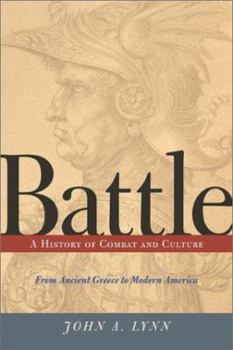Battle: A History of Combat and Culture
Select Format
Select Condition 
Book Overview
Battle: A History of Combat and Culture spans the globe and the centuries to explore the way ideas shape the conduct of warfare. Drawing its examples from Europe, the Middle East, South Asia, East... This description may be from another edition of this product.
Format:Hardcover
Language:English
ISBN:0813333717
ISBN13:9780813333717
Release Date:June 2003
Publisher:Basic Books
Length:432 Pages
Weight:1.65 lbs.
Dimensions:1.4" x 6.5" x 9.5"
Customer Reviews
5 ratings
Essential reading for anyone interested in military history
Published by Thriftbooks.com User , 15 years ago
Awesome book! Lynn's model on the discourse versus the reality of war is invaluable for every student of military history. Even though this is high level scholarship the book is very reader friendly. Apart from creating his own model Lynn should also be given credit for effectively disarming Victor Davis Hanson's thesis on a "western way of war".
Battle Joined
Published by Thriftbooks.com User , 17 years ago
John Lynn's "Battle" is a well-written and incisive look at an important historical subject. In a time of war, it is an important reminder of the lessons of history. Colorful examples and thoughtful commentary can be found throughout this tremendous work.
A Cultural view of Military History
Published by Thriftbooks.com User , 18 years ago
A very interesting discourse on the culture of warfare. He brings an interesting point of view to the table regarding how our culture determines the way we go to war. There has been some discussion on a 'western' way of going to war. And his analysis begins with the Greeks first defining the western way. ==From the Greeks he discusses some aspects of the ancient Chinese and other Eastern aspects, and goes on to discuss where East has fought West around the world. Over time also the ways of warfare have changed. To an extent this has come from equipment, but also from basic cultural differences between the fighting forces. The cultures of France and Germany were certainly different in the Ardennes in 1940. And the cultural differences between the Japanese and the Americans were immense. During the long Cold War, the cultures of the USSR and the USA were different, yet surprisingly close when compared with today's cultural differences between al Queda and the rest of us.
Definitively studies the history of war worldwide
Published by Thriftbooks.com User , 20 years ago
A work of impressive scholarship by noted expert on seventeenth and eighteenth-century warfare John A. Lynn (Professor of History, University of Illinois, Urbana-Champaign), Battle: A History Of Combat And Culture From Ancient Greece To Modern America definitively studies the history of war worldwide, including how ideas can carry more weight on the battlefield than heavy artillery. Exploring the influence that a culture's values has on armed conflict and vice versa, Battle: A History Of Combat And Culture is both a trek through time and a window of insight into the complex tangles of human society as exemplified by combat and conquest. Battle is a welcome addition to Military History Studies reference collections, as well as non-specialist general readers with an interest in the history of warfare and its influences upon the societies that engaged it as a tool of international relations -- willingly or unwillingly.
Harshly critical of Victor Davis Hanson
Published by Thriftbooks.com User , 20 years ago
Lynn completely disproves Hanson's thesis about the Western way of warfare in the opening chapters of Battle. Lynn cites the examples of the ancient Chinese and Indian armies as having the same organization of the ancient Greek armies although they were not based on democratic ideals. The Chinese armies were organized around harsh dicipline and personal example by its leaders while the Indian armies were formed around caste allegiances.Moreover the Greek method of warfare was abondoned in Roman times through the emergence of the professsional army. Lynn also believes that there was no set example of "Oriental," fighting because the Chinese relied upon mass armies while the Indians based their warmaking on subversion and assasination. The middle chapters, Lynn contradicts Hanson in that European armies during the medeval and elightenment periods avoided battle and relied upon seiges. Lynn also describes the development of the Sepoys and how they became an effective fighting force by mixing the European invention of the regiment with local and religious allegiances. In the section about Clausewitz, Lynn states Clausewtiz's ideas about decisive battle and the national will have no use in the age of limited warfare. Lynn also disagrees with John Dower theory about race in the Pacific War by writing that different cultural assumptions about surrender led to the totality of the conflict. In his section about the Egyptian army, Lynn states how the Egyptian army by detailing every last movement by their army during the canal crossing in 1973 compensated for the poor quaility of the junior Egyptian officers. I would reccomend this book for anyone interested in new theories about culture and war that disprove the writings of Hanson and Keegan.




